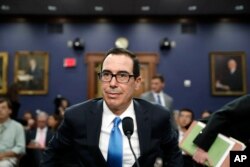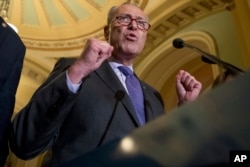U.S. lawmakers will have three weeks to raise America’s $20 trillion borrowing limit and avert a potential debt default when Congress gets back to work next month — the first such deadline to occur during the Trump administration.
If recent history is a guide, raising the debt ceiling will be anything but drama-free, with lawmakers demanding concessions in return for votes to prevent an outcome that could throttle global finances: the U.S. government unable to pay its bills.
The White House is pushing for a so-called “clean” debt ceiling increase with no conditions attached, something Congress delivered dozens of times prior to the Obama administration.
“I respectfully urge Congress to protect the full faith and credit of the United States by acting to increase the statutory debt limit as soon as possible,” Treasury Secretary Steven Mnuchin wrote to congressional leaders earlier this year.
Call for spending cuts
On Capitol Hill, Republican fiscal hawks are demanding spending cuts.
“Most Republicans want to do something to lower the trajectory of the debt,” Republican Congressman Tom Cole of Oklahoma said Tuesday on MSNBC. “A clean debt ceiling hike is like having a credit card and saying, ‘I’ve reached my [credit] limit. I’m going to make the limit higher without changing my spending habits.’”
“The biggest conflict we’ve seen so far on this issue isn’t between the parties,” noted political analyst Molly Reynolds of the Washington-based Brookings Institution. “It’s within the Republican Party, where some rank-and-file members, especially in the House, have been pushing back against the idea of a clean [debt ceiling] increase.”
Democrats
Some Democrats, meanwhile, have a demand of their own: that Republicans forgo any debt-incurring tax cuts.
“It’s going to be very hard to raise the debt limit if their [Republicans’] intent is to increase the debt by massive tax cuts on the very wealthy,” Senate Minority Leader Chuck Schumer, a New York Democrat, said last month.
In 2011, protracted congressional wrangling over the borrowing limit led to a downgrade of America’s creditworthiness. Much as they do today, Republicans demanded fiscal reforms as a condition for hiking the debt ceiling.
“At a time when we’re borrowing 40 cents out of every dollar we spend, we want to make sure we take a significant step to reduce spending,” Republican Senator Lamar Alexander of Tennessee said days before the 2011 fiscal deadline.
Congressional Democrats responded by accusing Republicans of taking the U.S. economy hostage through debt ceiling demands. At the White House, then-President Barack Obama argued that linking the debt ceiling to spending reforms was misguided.
“It’s not a vote that allows Congress to spend more money,” Obama said. “Raising the debt ceiling simply gives our country the ability to pay the bills that Congress has already racked up. It gives the United States of America the ability to keep its word.”
Standoff feared
In the end, Congress raised the debt ceiling in 2011 while also imposing spending caps. Shortly thereafter, Standard and Poor’s downgraded the U.S. government’s credit rating based on what it saw as chronic political chaos in Washington.
That chaos could prove even more severe in the current debt ceiling standoff, according to analysts.
“Breaching the [debt] limit is sufficiently consequential that we should always be worried about whether Congress, especially in periods of dysfunction, can get it done,” Reynolds said. “Also, even if Congress has historically managed to do what’s necessary, how they’ve done that has come with consequences.”
In reality, the federal government reached its borrowing limit in March of this year. To avoid default, the Treasury Department took what it termed “extraordinary measures” such as postponing investments in a variety of pension programs for federal retirees.
Secretary Mnuchin has advised that Treasury’s ability to use bookkeeping slight-of-hand to avoid default runs out on September 29.












